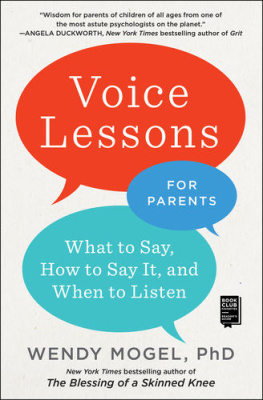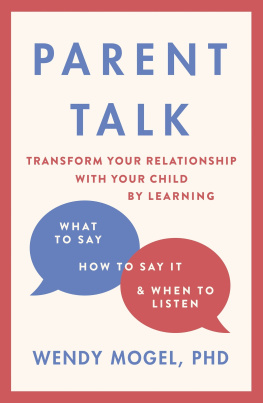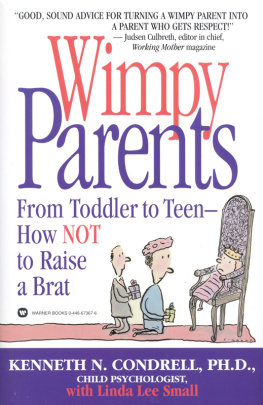Thank you for downloading this Simon & Schuster ebook.
Get a FREE ebook when you join our mailing list. Plus, get updates on new releases, deals, recommended reads, and more from Simon & Schuster. Click below to sign up and see terms and conditions.
CLICK HERE TO SIGN UP
Already a subscriber? Provide your email again so we can register this ebook and send you more of what you like to read. You will continue to receive exclusive offers in your inbox.
We hope you enjoyed reading this Simon & Schuster ebook.
Get a FREE ebook when you join our mailing list. Plus, get updates on new releases, deals, recommended reads, and more from Simon & Schuster. Click below to sign up and see terms and conditions.
CLICK HERE TO SIGN UP
Already a subscriber? Provide your email again so we can register this ebook and send you more of what you like to read. You will continue to receive exclusive offers in your inbox.
ALSO BY WENDY MOGEL
The Blessing of a Skinned Knee
The Blessing of a B Minus

Scribner
An Imprint of Simon & Schuster, Inc.
1230 Avenue of the Americas New York, NY 10020
www.SimonandSchuster.com
Copyright 2018 by Wendy Mogel
All rights reserved, including the right to reproduce this book or portions thereof in any form whatsoever. For information address Scribner Subsidiary Rights Department, 1230 Avenue of the Americas, New York, NY 10020.
First Scribner hardcover edition April 2018
SCRIBNER and design are registered trademarks of The Gale Group, Inc., used under license by Simon & Schuster, Inc., the publisher of this work.
For information about special discounts for bulk purchases, please contact Simon & Schuster Special Sales at 1-866-506-1949 or business@simonandschuster.com.
Jacket design by Jaya Miceli
The Simon & Schuster Speakers Bureau can bring authors to your live event. For more information or to book an event, contact the Simon & Schuster Speakers Bureau at 1-866-248-3049 or visit our website at www.simonspeakers.com.
ISBN 978-1-5011-4239-0
ISBN 978-1-5011-4241-3 (ebook)
To Ann and Leonard Mogel
It was as though she had stepped into a boat and was swept off by a strong current. She did not know what all the words meant, and she could not pronounce a good many of the names, but nobody interrupted to correct her, and she read on and on, steadied by the strongly marked rhythm, drawn forward swiftly from one clanging, sonorous rhyme to another.
Dorothy Canfield Fisher, from Understood Betsy, 1916
Authors Note
W hen I was a psychology student in the 1970s, some awful fictions were sold as fact: schizophrenia was caused by schizophrenogenic (overprotective yet rejecting) mothers; autism by refrigerator mothers; male homosexuality by weak dads, helpless to control their overbearing wives. During the same era, the womens movement aimed to banish the concept of biology as destiny. Girls and boys came into the world as equals. What mattered was nurture. Provide girls with blocks and boys with dolls, and the differences would evaporate. While well-intentioned, this approach to protecting rights and allowing for growth and unlimited opportunity was too narrow and didnt withstand scientific scrutiny.
Yet the 1970s also yielded some awesome truths that hold today. One was the theory of psychological androgyny developed by social psychologist Sandra Bem. Her robust research revealed that girls who exhibited some traits traditionally considered masculine and boys who displayed some that were considered feminine were emotionally healthier than children whose range of attitudes and behaviors fell at the extremes of gender norms. Bem found that narrowly defined, restrictive gender roles had a negative effect on individuals and on society as a whole.
Bem began a movement that shifted from fixed definitions of gender expression to todays more nuanced understanding of the rich and complex variations of human identity and sexuality. In the late 1980s, I had an experience that helped me deepen my insight into this topic. The parents of four-and-a-half-year-old Ash came to see me about their sons perplexing behavior. His mom said, At least once a day, Ash suddenly turns his head and looks upward with a concerned expression on his face. Then he lifts his arms, bends both elbows, scrunches up his fists, and dashes across the room on his toes. I asked him why he was doing this and he explained in a matter-of-fact tone, When Cinderella sees the clock is about to chime midnight, she has to gather up the skirts of her ball gown so she can fly over to the pumpkin coach really, really fast. Dr. Mogel, were worried hes suffering from gender identity disorder.
At that time, GID was considered a mental disorder and was much in the news. To determine an appropriate diagnosis and treatment plan, I consulted with two senior psychiatrist colleagues who specialized in working with young boys who had this condition. One held a philosophy of rigid rules akin to those employed by gay conversion therapists: Tell those parents to immediately purge the boys room of any dolls and feminine costumes, not to permit any playdates with girls, and that Dad has to start playing sports with him every day. They should also enroll him in at least one peewee team.
The other colleague said, Tell the parents to let him be. To celebrate his imagination and even join in the fun. Mom might ask, Do the seats in a pumpkin coach have cushions? Or are they more like benches?
When I met with Ashs parents I told them not to worry over his present behavior or forecast his future. All we know now is that sometimes hes Cinderella and we love him. And that your respect for his creativity and self-expression is vital for his growth.
The 1990s brought advanced technological tools in neuroscience, providing a flood of data about gender differences in rates of cognitive, emotional, and physical development; sensory perceptions like hearing and sight; anatomy and brain architecture; the effect of hormones on emotions; and other attributes that are subtle but significant when communicating with children and teenagers. We dont yet have a substantial body of research on whether transgendered people have brains more similar to their experienced gender than to their assigned gender (the one checked off on the box on their birth certificate) but the work has begun. Today most mental health professionals (and young people) understand that gender falls on a spectrum rather than into neat binary categories, and that each persons experience of who they are, how they want to dress, what name they prefer to be called, and who they are drawn to for companionship, romance, and sexual involvement dont fit into predetermined or fixed classifications.
With technology and social media, parents must be lifelong learners in order to make and enforce sensible and protective rules for their children. The same is true of understanding gender expression. If you want your child to see you as a trusted traveler, you have to do your homework. I know of no better starting place than the website genderspectrum.org. Its a jargon-free, non-polemical, sober, and thorough resource for educators, parents, and teenagers.
In reading the Voice Lessons chapters about boys and girls and my statements about attitudes and behaviors of mothers and fathers, please insert mental quotation marks as needed around the references to gender differences. The same applies if you are a single parent, a same-sex couple, or belong to any of the new family configurations that now coexist alongside the more traditional nuclear family.
Next page









